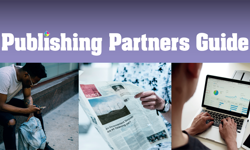Taking the logic behind Pareto’s 80/20 principle, marketing to your existing customer should take priority over marketing to new prospects. In practice, most subscription marketers would acknowledge that acquisition nearly always takes up more time and money than renewal.
On the retention front, there is possibly a valid argument about diminishing return on investment past a certain number of renewal efforts and reactivation campaigns. I could argue otherwise, but that’s not the focus of this article.
The point I want to get across is the value of cross-selling additional products to your existing customers. Where you have the opportunity to sell another magazine from the same stable, not only is cross-selling cost effective and highly responsive but it deepens your overall relationship.
Makes sense, doesn’t it? After all, how many new friendships come from introductions within an existing range of friends and acquaintances? And, how rarely, in truth, do strangers on a train become something more than just strangers?
If you make the right offer at the right time in the right way, cross-promotion campaigns will deliver you your all-time best response rates. Sometimes, these will exceed your wildest dreams, such as an all-time best conversion rate of 60% in one special interest consumer magazine sector.
If you have a great product, be confident in investing in that product and comfortable in cross-selling that product to subscribers of a sister magazine. Concerns about cannibalisation do worry many people, but I firmly believe that strong products with differentiated propositions can be cross-sold with virtually zero cannibalisation.
Database analysis of real-life launch histories, around Olive and Good Food, has proven that cross-sell can grow both your overall market share, and also the overall market for that category with virtually no loss to the existing titles.
We are spoilt for choice when it comes to low-cost opportunities to talk to subscribers and, indeed, newsstand purchasers of our magazines. Here are just a few:
1. Off-the-page
Advertising a sister publication off-the-page works, particularly when you are explicit about the family relationship and make the offer low risk, with a money back guarantee. Using copy effectively to sell the USP of the cross-sold title will also improve response.
2. Inserts
Great for promoting a ‘3 for £1 delayed DD trial’ or any other straightforward offer. Very effective for portfolio activity around a Christmas gift campaign. Excellent for a ‘send no money now, bill me later’ offer.
3. Onserts
Wraps around the magazine have a great impact and make a big splash around a single message, such as a new launch. Equally, printed material enclosed within the magazine polywrap, outside of the magazine, can be effective where the enclosing machine at the printers is up to capacity on inserts.
4. Carrier sheets
Combined with clear polywrap, address carriers can be highly effective in cross-sell campaigns. They turn your magazine mailing into a piece of direct mail, for the price of an A4 printed page. A word of advice, never let your production department take charge of printing your polywrap or carrier sheets – you will lose marketing opportunities as they race to cut costs by standardising the print run over a year.
5. Editorial endorsement
Talking about sister products in editorial can do wonders. Equally, using an editorial voice to introduce an offer on an advertising page really works. The Spectator’s use of "Boris Johnson would like to make you a special offer", was a masterly illustration of exactly this kind of approach.
These low-cost easy channels are a great starting point for cross-sell, and will yield between 0.5% – 10% response rates, depending on product, targeting and offer.
All the above are successful and valuable traditional channels for cross-selling. However, for me, the really big opportunity is via one-to-one marketing. Direct mail, email and telemarketing give a great opportunity for tailored campaigns and even better response rates.
Increasingly, email marketing is taking the place of direct mail within publishing houses, and outbound telemarketing is struggling within the climate of increasing TPS registration. These channels are, however, well established and form part of many publishers’ marketing tool kit when cross-sell campaigns run.
Inbound telephone ordering
However, one of the most obvious and still under-utilised channels for cross-sell is inbound telephone ordering. When the customer calls in to place their order, you are perfectly placed to cross-sell to a customer poised and ready to buy.
Offering a trial subscription or a preferential offer on a second subscription to a sister title is a great way of generating a substantial number of additional sales. Even for those publishers who don’t have a large portfolio themselves, a partnership approach with other publishers would deliver the same benefits on a mutually rewarding basis.
Within the direct marketing industry, there is some suspicion that this is beyond the skill base of customer service agents, and that such an operation is best outsourced to a sales team with a more aggressive approach.
One common concern is a belief that sales and customer service are two different beasts, and that customer care staff would simply be unable to sell.
Interestingly, recent activity for several consumer publishers, BBC among them, suggests otherwise. While the traditional sales operation is best placed to deliver on outbound campaigns targeting colder prospects, the softer skill set of the customer service staff can generate excellent cross-sell response rates.
Put simply, because the customer is already warm, you do not need the hard sell. With a simple offer structure, the correct training, a solid incentive scheme for the staff and a full time monitoring resource, customer service agents can sell and generate great results: 5 – 20% conversion. These factors are as simple as they sound but are all essential for success. To single out the most important among them, I would point to monitoring. It is essential to make sure that the staff consistently promote the offer, and put it to everyone who orders. This will lead to success, which in turn builds confidence and further increases sales.
Importantly, you don’t need to give too much away to make the sale. Your customer is already in the buying frame of mind. It’s the same psychological approach as putting impulse purchase items next to till points in supermarkets or WHSmith.
Data driven future
All this is great news for the industry, but, even more exciting for me is a vision of a truly customer focused, data-driven call centre. In this vision, we will tailor the offer in light of what is already known about our customer.
Direct marketing, by its very nature, is all about one-to-one communication and life as a subscriptions marketer is becoming increasingly interesting. Even editorial colleagues, on the other side of the publishing fence, are starting to see us less as "pointy heads" buried in Excel and numbers, and more as the source who knows most about their readers, based on analysis of real life behaviour.
A bit Big Brother? Possibly, but I think we have all experienced the good and the bad of cross-selling in our home life as consumers. Every time I use telephone banking to pay a bill, my bank tries to sell me another mortgage deal. I always say no. I’ve already had the spiel, and know that they can’t match the deal I get through a lesser-known building society. Maybe one day they’ll cotton on to this and sell me something I might want…
On the other hand, when I called up to buy organic baby products from a small catalogue company, they pulled up my previous order and told me about a special offer on a repeat of that item. I placed my intended order and spent another £20 on the offer they had recommended. The transaction pleased us both. They had got an additional sale and I had made a saving. If they take a similar approach next time I place an order, I will be only too delighted.
Of course, this is much easier for smallish new companies with up-to-date systems. It is much harder for the bigger company using legacy systems developed rather too long ago.
Using data-mining tools to interrogate the database and provide targeting for your offers is the way forward. For example, making longer-term subscription offers to a large database of mainly annual subscribers can be inefficient. With a database marketing solution, you could just target repeat purchasers with high lifetime spend, or those that live in very well off postcodes.
Before I finish, here are some simple rules for cross-sell success:
1. Don’t spam - only make an offer if you believe that customer will want it.
2. Think about your existing customer and tailor your offer accordingly.
3. Value your offer in their eyes and not your own.
4. Make it easy with a no risk proposition.
5. Sign them up for the long term wherever possible.
6. Talk to them where and when they are most responsive.
Cross-sell offers a low risk, relatively cheap means of achieving increased sales and greater market size. So, what are you waiting for? Expand your customers’ horizons - introduce them to that sister publication they won’t be able to live without.
FEATURE
New horizons for old customers
Making more money is what most publishers strive for each year. Often the best source of new money is your existing customers – people you already have a relationship with. Jess Burney looks at the secrets of successful cross-sell.










